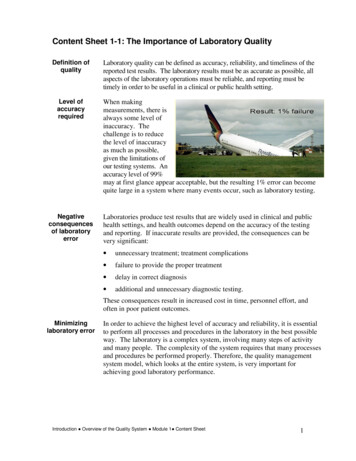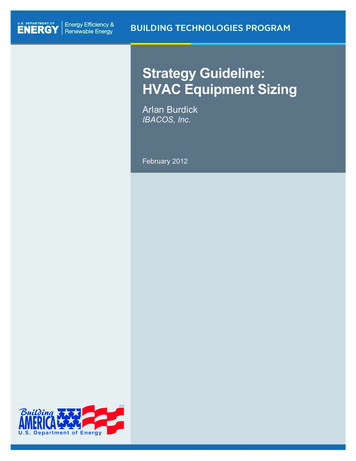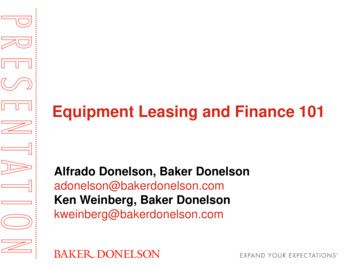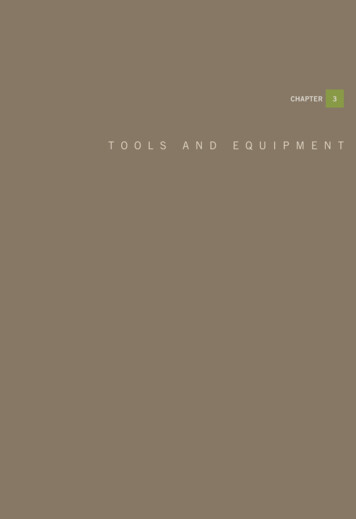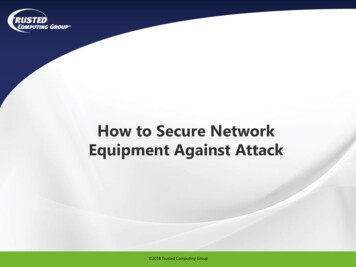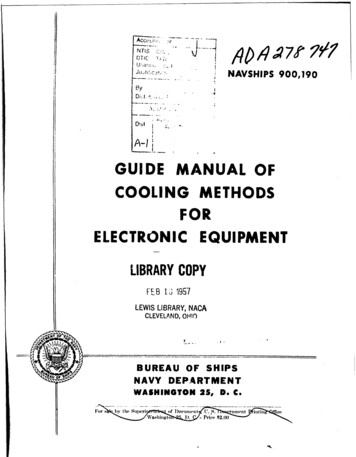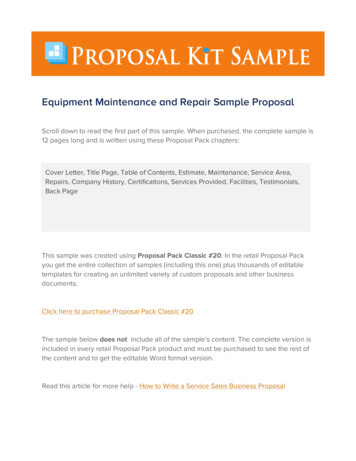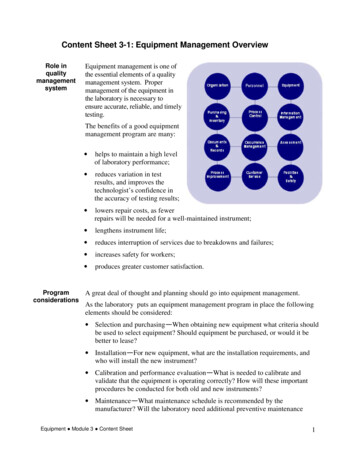
Transcription
Content Sheet 3-1: Equipment Management OverviewRole inqualitymanagementsystemEquipment management is one ofthe essential elements of a qualitymanagement system. Propermanagement of the equipment inthe laboratory is necessary toensure accurate, reliable, and timelytesting.The benefits of a good equipmentmanagement program are many: helps to maintain a high levelof laboratory performance; reduces variation in testresults, and improves thetechnologist’s confidence inthe accuracy of testing results; lowers repair costs, as fewerrepairs will be needed for a well-maintained instrument; lengthens instrument life; reduces interruption of services due to breakdowns and failures; increases safety for workers; produces greater customer satisfaction.ProgramA great deal of thought and planning should go into equipment management.considerationsAs the laboratory puts an equipment management program in place the followingelements should be considered: Selection and purchasing—When obtaining new equipment what criteria shouldbe used to select equipment? Should equipment be purchased, or would it bebetter to lease? Installation—For new equipment, what are the installation requirements, andwho will install the new instrument? Calibration and performance evaluation—What is needed to calibrate andvalidate that the equipment is operating correctly? How will these importantprocedures be conducted for both old and new instruments? Maintenance—What maintenance schedule is recommended by themanufacturer? Will the laboratory need additional preventive maintenanceEquipment Module 3 Content Sheet1
procedures? Are current maintenance procedures being conducted properly? Troubleshooting—Is there a clear procedure for troubleshooting for eachinstrument? Service and repair—What is the cost? Can the laboratory obtain the necessaryservice and repair in its geographical area? Retiring and disposing of equipment—What must be done to dispose of oldequipment when it needs to be replaced?OversightIt is the responsibility of the laboratory director to: oversee all the equipment management systems in the laboratory; ensure that all persons who will be using the instruments have beenappropriately trained and understand how to both properly operate theinstrument and perform all necessary routine maintenance procedures.Equipment management responsibility may be specifically assigned to atechnologist in the laboratory. In many laboratories there is a person who has goodskills with equipment maintenance and troubleshooting. Giving this person the roleof oversight of all equipment is recommended.Oversight of an equipment management program includes: assigning responsibilities for all activities; assuring that all personnel are trained on operation and maintenance; monitoring the equipment management activities:oreview all equipment records routinely;oupdate maintenance procedures as necessary;oensure that all procedures are followed.Note: day-to-day maintenance should be the responsibility of the technical operator.Everyone who uses the equipment should be trained in calibration and dailymaintenance.Equipment Module 3 Content Sheet2
Content Sheet 3-2: Selecting and Acquiring EquipmentSelectingequipmentSelecting the best instrument for the laboratory is a very important part ofequipment management. Some criteria to consider when selecting laboratoryequipment are listed below. Why and how will the equipment be used? The instrument should bematched against the service the laboratory provides. What are the performance characteristics of the instrument? Is it sufficientlyaccurate and reproducible to suit the needs of the testing to be done? What are the facility requirements, including the requirements for physicalspace? Will the cost of the equipment be within the laboratory’s budget? Will reagents be readily available? Will reagents be provided free of charge for a limited period of time? If so,for how long? How easy will it be for staff to operate? Will instructions be available in a language that is understood? Is there a retailer for the equipment in the country, with available services? Does the equipment have a warranty? Are there any safety issues to consider?If the decisions about purchasing are made outside the laboratory, for exampleby a central purchasing body, the laboratory manager should provideinformation that will support selecting equipment that will best serve the needsof the laboratory. In areas where there are national programs for purchasingstandard equipment, the laboratories of the country should have some input todecisions. In addition, in areas where donors are likely to provide some of theequipment that is used, laboratory management should have input into choice ofequipment. If this is not possible, management should consider decliningequipment, if inappropriate for laboratory needs.AcquiringequipmentIs it better to purchase, rent or lease equipment? When making this decision, it isa good idea to factor in repair costs. The initial cost of an instrument may seemreasonable, but it may be expensive to repair. Also consider savings that couldbe negotiated if the laboratory needs more than one piece of equipment.The manufacturer should provide all of the necessary information to operate andmaintain equipment.Equipment Module 3 Content Sheet3
Before purchasing ask if: wiring diagrams, computer software information, a list of parts needed, andan operator’s manual are provided; the manufacturer will install the equipment and trainstaff (covering travel expenses as necessary) as part ofthe purchase price; the warranty includes a trial period to verify that theinstrument performs as expected; the manufacturer’s maintenance can be included in the contract and if so,whether maintenance is provided on a regular basis.Determine if the laboratory can provide all the necessary physical requirements,such as electricity, water, and space. There must be adequate room to move theequipment into the laboratory; consider door openings and elevator access.InstallingequipmentBefore equipment is installed, verify that all physical requirements (electrical,space, doors, ventilation, and water supply) have been met. Other things toconsider are: The vendor’s responsibilities for installation should be confirmed in writingprior to beginning the installation process. A checklist of the expected performance specifications should be developed,so that performance can be quickly verified as soon as the equipment isinstalled.Whenever possible, it is best to have the manufacturer install laboratoryequipment; this will likely improve the conditions of the warranty, and also mayensure that the installation is done properly and quickly.If equipment is installed by the laboratory: check that the package contents contain all of the parts; make a copy of any software that is part of the system; do not allow the equipment to be used before it is completely installed,performance is verified, and testing personnel are trained.Equipment Module 3 Content Sheet4
Content Sheet 3-3: Getting Equipment Ready for ServiceAfterinstallationAfter equipment has been installed, the following details need to be addressed beforeputting the equipment into service: assign responsibility for performing the maintenance and operation programs; develop a system for recording the use of parts and supplies (see Module 4Purchasing and InventoryOverview); implement a written plan forcalibration, performanceverification, and properoperation of the equipment; establish a scheduledmaintenance program thatincludes daily, weekly, andmonthly maintenance tasks; provide training for alloperators; only personnel who have been trained specifically to properly use theequipment should be authorized as operators.Designate those authorized to use the equipment and when it is to be used.EquipmentcalibrationFollow the manufacturer’s directions carefully when performing the initialcalibration of the instrument. It is a good idea to calibrate the instrument with eachtest run, when first putting it into service. Determine how often the instrument willneed to be recalibrated, based on its stability and on manufacturer’srecommendation. It may be advantageous to use calibrators provided by orpurchased from the manufacturer.Performance Prior to testing patient specimens, it is important to evaluate the performance ofevaluationnew equipment to ensure it is working correctly with respect to accuracy andprecision.In addition, test methods using kits or laboratory instruments need to be evaluatedfor the ability to detect disease (sensitivity, specificity, positive and negativepredictive value), and to determine normal and reportable ranges.Verification of manufacturers’ performance claims—Manufacturers provideperformance evaluations for testing methods using their kits or instruments, andinclude the information in the package inserts or operators’ manuals. However,laboratories need to verify the manufacturers’ performance claims, anddemonstrate they can get the same results using the kits or equipment in theirEquipment Module 3 Content Sheet5
laboratory, with their personnel.Some of the steps that should be followed to verify performance include: testing samples with known values and comparing the results to the expected orcertified value; if equipment istemperaturecontrolled,establishing thestability anduniformity of thetemperature.Validation of newequipment andassociated techniques—If the equipment and/or associated techniques are new, validation processes will beimportant. This can be carried out by running samples in parallel on both previousand new equipment/methods for a period of time to determine that the expectedresults can be obtained. These validation procedures should be completelyrecorded.FunctionchecksIn order to verify that equipment is working according to the manufacturer’sspecifications, it is necessary to monitor instrument parameters by performingperiodic function checks. This should be done before using the instrument initially,then with the frequency recommended by the manufacturer. These function checksshould also be done following any instrument repairs. Some examples of functionchecks are daily monitoring of temperatures and checking the accuracy ofwavelength calibration.Equipment Module 3 Content Sheet6
Content Sheet 3-4: Implementing an Equipment Maintenance ProgramPreventivemaintenancePreventive maintenance includes measures such as systematic and routinecleaning, adjustment, and replacement of equipment parts at scheduled intervals.Manufacturers generally recommend a set of equipment maintenance tasks thatshould be performed at regular intervals: daily, weekly, monthly, or yearly.Following these recommendations will ensure that the equipment performs atmaximum efficiency and will increase the lifespan of the equipment. This willalso help to prevent: inaccurate test results due to equipment failure delays in reporting results lower productivity large repair costs.MaintenanceplanA maintenance plan will include preventive maintenance procedures as well asprovision for inventory, troubleshooting, and repair of equipment. Whenimplementing an equipment maintenance program, some of the initial steps willinclude what follows. Assign responsibility for providing oversight. Develop written policies and procedures for maintaining equipment,including routine maintenance plans for each piece of equipment. The planshould specify the frequency with which all maintenance tasks should beperformed. Develop the format for records, create logs and forms, and establish theprocesses to maintain records. Train staff on the use and maintenance of the equipment, and assure that allstaff understand their specific responsibilities.It is recommended that a label be attached to the instrument indicating when thenext maintenance or service should be performed.EquipmentinventoryThe laboratory should keep an inventory log of all equipment in the laboratory.The log should be updated with information on new equipment, as it is added,and include documentation of when old equipment is retired.For each piece of equipment, the equipment inventory log should have a record of: instrument type, make and model number, and serial number of theinstrument, so that any problems can be discussed with the manufacturer; date the equipment was purchased, and whether it was purchased new, used,or reconditioned;Equipment Module 3 Content Sheet7
manufacturer/vendor contact information; presence or absence of documentation, spare parts, and maintenance contract; warranty’s expiration date; specific inventory number indicating the year of acquisition; this is especiallyuseful for larger laboratories. For example, use the style “YY-number” (04001, 04-002, etc.) where “YY-number” equals the last two numbers of theyear followed by a number attributed in the year.An inventory process must be conducted if the laboratory does not have anexisting inventory system for equipment. This could be conveniently organized following a model grid room by room,for example, reception, sampling, serology, and parasitology. During the inventory, the condition of the equipment should be documentedas:o functionalo partially functional, oro non-functional. Equipment that is not functioning needs to be evaluated asto whether or not it can be repaired. Non-repairable equipment should beretired, and work should be scheduled for equipment needing repair.Inventory ofspare partsTo ensure that the laboratory does not run out of spare parts, an inventory recordof those used most frequently should be kept for each piece of equipment. Therecord should include: part name and number; average use of the part, and the minimum to keep on hand; cost; date when the part is placed into storage, and when it is used (in and out stocklog); quantity of each part remaining in inventory.Equipment Module 3 Content Sheet8
Content Sheet 3-5: Troubleshooting, Service, Repair, andRetiring EquipmentWhat is thesource oftheproblem?Problems with equipment may present in many ways. The operator may notice subtlechanges such as drift in quality control or calibrator values or obvious flaws inequipment function. Sometimes, the equipment fails to operate. It is important to teachoperators to troubleshoot equipment problems in order to quickly get the equipmentfunctioning and resume testing as rapidly as possible.When an operator observes instrument drift, it is important to repeat the preventivemaintenance procedures as a first step to resolve the problem. If this does not work,proceed with troubleshooting processes.TroubleshootingManufacturers frequently provide a flowchart that can help determine the source ofproblems. Some of the questions to consider are listed below. Is the problem related to a poor sample? Has the sample been collected and storedproperly? Are factors such as turbidity or coagulation affecting instrumentperformance? Is there a problem with the reagents? Have they been stored properly, and are theystill in date? Have new lot numbers been introduced without updating instrumentcalibration? Is there a problem with the water or electrical supply? Is there a problem with the equipment?Make one change at a time based on symptoms. If equipment is the problem, reviewthe manufacturer’s instructions to verify that all procedures are being followedcorrectly.Whenproblemscannot becorrectedIf problems cannot be identified and corrected in-house, attempt to find a way tocontinue testing until the equipment can be repaired. Some ways to achieve this are asfollows. Arrange to have access to back-up instruments. It is often too costly for the laboratoryto have its own back-up instruments, but sometimes a central stores agency canmaintain back-up instruments to be shared throughout the local area or country. Ask the manufacturer to provide a replacement instrument during repairs. Send the samples to a nearby laboratory for testing.Be sure to notify the appropriate providers that that there are problems and that therewill probably be delays in completing the testing.Equipment Module 3 Content Sheet9
Do NOT use faulty equipment! Seek help from themanufacturer or other technical expert.Place a note on the equipment so all staff are aware that itis not in use.Service and Manufacturers may provide service and repair of equipment that is purchased fromrepairthem. Be sure to set up a procedure for scheduling service that must be periodicallyperformed by the manufacturer. When instruments need repair, remember that somewarranties require that repairs be handled only by the manufacturer.Large facilities sometimes have biomedical service technicians in-house who performequipment maintenance and repair.Routine service should be scheduled so as not to interrupt the flow of work.RetiringanddisposingofequipmentIt is very important to have a policy andprocedures for retiring older laboratoryequipment. This will usually occur when it isclear that the instrument is not functioning andis not repairable, or when it is outmoded andshould be replaced with new equipment.Once a piece of equipment is fully retired and ithas been determined that it has no furtherusefulness, it should be disposed of in anappropriate manner. This last step is oftenneglected in laboratories, and old equipmentaccumulates, taking up valuable space and sometimes creating a hazard.When disposing of equipment, salvage any useable parts, particularly if the equipmentis being replaced with another similar one. Then consider any potential biohazards,and follow all safety disposal procedures.Equipment Module 3 Content Sheet10
Content Sheet 3-6: Equipment Maintenance DocumentationDevelopingdocumentsand policiesforrecordkeepingEquipment documents and records are an essential part of the quality system.The policies and procedures for maintenance should be defined in appropriatedocuments, and keeping good equipment records will allow for thoroughevaluation of any problems that arise. (Module 16: Documents and Records)Each major piece of equipment will have its own equipment maintenancedocument. Smaller, commonly used equipment such as centrifuges andpipettes may be managed with an equipment maintenance document ormanual that deals with all such equipment in the laboratory.An equipment maintenance document should include: step-by-step instructions for routine maintenance, including frequency ofperformance, and how to keep records of performance; instructions for carrying out function checks, frequency of performance,and how to record the results; directions for calibrating the instrument; guide for troubleshooting; any required manufacturer’s service and repair; list of any specific items needed for use and maintenance, such as spareparts.For major equipment, include identification of the specific instrument, andperhaps information on its performance.RecordingmaintenanceinformationEach piece of equipment should have a dedicated logbook documenting allcharacteristics and maintenance elements: preventive maintenanceactivities and schedule; recording of function checks andcalibration; any maintenance performed bythe manufacturer; full information on any problemthat the instrument develops, thesubsequent troubleshootingactivity, and follow-upinformation regarding resolution of the problem. In recording problems, besure to record:Equipment Module 3 Content Sheet11
o date problem occurred, and when equipment was removed fromservice;o reason for breakdown or failure;o corrective action taken; including a note about any service provided bythe manufacturer;o date returned to use;o any changes to procedure for maintenance or function checks as aresult of the problem.Some of the tools that are helpful for keeping records on equipmentmanagement are: charts logs checklists graphs service reports.The log book should be available for review during the e
Content Sheet 3-1: Equipment Management Overview Role in quality management system Equipment management is one of the essential elements of a quality management system. Proper management of the equipment in the laboratory is necessary to ensure accurate, reliable, and timely testing. The benefits of a good equipment management program are many:File Size: 451KB


